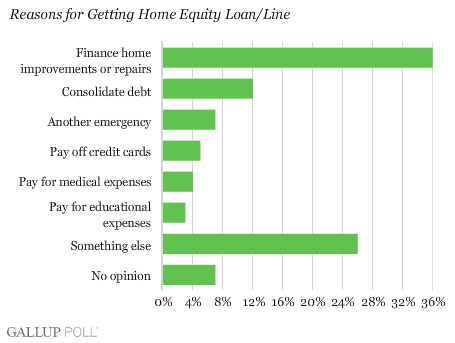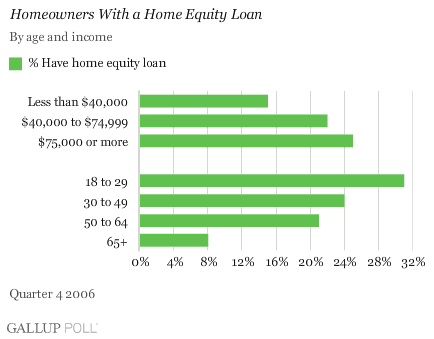PRINCETON, NJ -- Wells Fargo gave consumers a small hint a few weeks ago about what is to come if housing remains depressed and the pace of mortgage foreclosures builds. Wells Fargo's write-off of $1.4 billion on $11.9 billion of home equity loans it feels are currently most at risk is just the tip of the iceberg for financial institutions. Many major financial institutions, as well as most of their smaller banking counterparts, have significant exposure to the home equity loans and lines that now total more than $1 trillion. When the Fed cut the federal funds rate one-quarter percentage point to 4.25% at Tuesday's Federal Open Market Committee (FOMC) meeting, it appeared that monetary policy-makers were not greatly concerned about the unsettled conditions in the financial markets or the ever-expanding consumer credit crunch. Wednesday, the Fed shifted that perception somewhat, showing that it is concerned about the financial markets; it followed up with a coordinated international effort to provide more liquidity to the global banking system.
Unfortunately, the Fed's two-day effort still suggests that it doesn't really understand the seriousness of the current consumer credit crunch. That situation may change significantly by the time the FOMC meets again in late January 2008.
Home Equity Loans Dominate Consumer Lending
Home equity loans have dominated consumer lending in recent years. Home equity loans and lines that once were used for home improvements are now used to make every type of consumer purchase from buying a car or a boat to financing a college education. As a result, home equity lending became the fastest growing form of consumer credit during the past decade.

These loans appeal to borrowers because they not only have lower interest rates than credit cards or personal loans but they also provide substantial tax advantages. For the lender, they provide a loan secured by the home -- the most important asset of middle-class Americans. Thus, it is not surprising that 25% of homeowners told ÆéûÜǨû§they had a first mortgage and a home equity loan or line in an Experian/ÆéûÜǨû§poll conducted late last year.

While the pervasiveness of home equity borrowing makes good sense when the loans are properly used and underwritten, they are also vulnerable to the same type of abuses as those associated with the so-called "subprime" mortgage debacle. In many instances, home equity loans were used in "piggyback" fashion to enable homebuyers to borrow 100% of the value of the houses they were buying. Often, the combination of loans involved was so complex that borrowers didn't really know where their first mortgage ended and their home equity loan began.
The Housing Debacle
Despite what some observers may say, conditions in the national housing market remain dismal at best. Over the past four months, roughly 8 in 10 investors have repeatedly said that conditions in the residential real estate market are getting worse, not better, according to the UBS/ÆéûÜǨû§Index of Investor Optimism poll. Until we see a significant change in these perceptions among investors, it seems to be too early to suggest the market has reached bottom.

Fed Needs to Change the Consumer/Investor Psychology
As the so-called "subprime"-related losses have been felt worldwide, structured financings and even the securitization process have come under increasing stress. But today's financial market stress, and the volatility it has generated on Wall Street, has yet to be fully reflected on Main Street. More importantly, the anemic response of public policy-makers to the potential for widespread mortgage foreclosures and housing price declines unseen for many decades leaves much to be desired. Now, we can add a Fed that seems more interested in econometric analysis and geopolitical globalization than current investor/consumer psychology.
Currently, lenders are tightening their underwriting standards to the old norms in response to their "subprime"-related losses and the mortgage lending excesses of recent years. These are much-needed changes, but the current tightening reflects past excesses in the mortgage and housing markets much more than conditions in the consumer lending markets. But these are just the beginnings of the consumer credit crunch set to unfold in the months ahead.
What the Fed should have done was to take every action possible -- cut the federal funds rate by more than 50 basis points, reduce the discount rate even more, and make it clear that it would continue pumping liquidity into the system as necessary to free up the credit markets -- to get out ahead of the "other shoe to drop" in response to falling housing prices and poor underwriting standards: the coming home equity lending debacle and its effect on consumer credit availability. Unfortunately, as was the case with the so-called "subprime" mess, the nation's monetary authorities are now positioned to be reactive as events unfold in the credit markets -- often not a winning strategy.
Survey Methods
Results for the Experian/ÆéûÜǨû§Personal Credit Index poll are based on telephone interviews with 3,053 adults, aged 18 and older, conducted October through December 2006. For results based on the total sample of consumers, one can say with 95% confidence that the margin of sampling error is ôÝ2 percentage points.
Investor results are based on telephone interviews with 804 investors, aged 18 and older, conducted Nov. 1-14, 2007. For results based on the total sample of investors, one can say with 95% confidence that the margin of sampling error is ôÝ4 percentage points.
